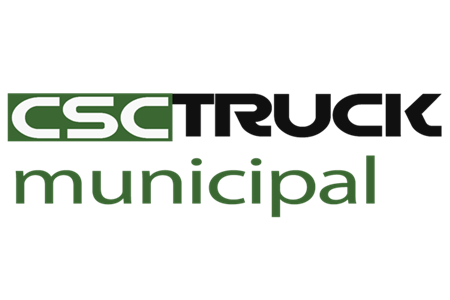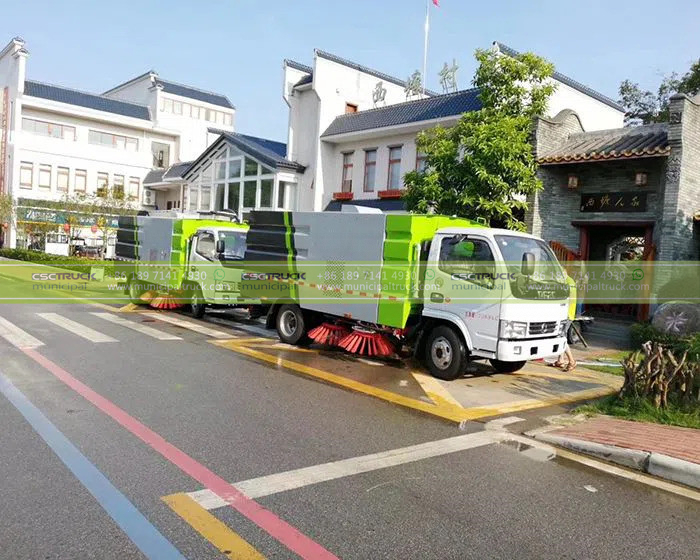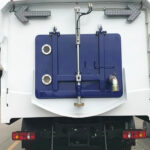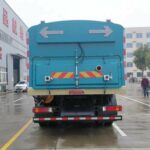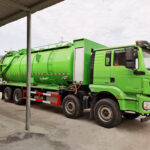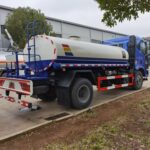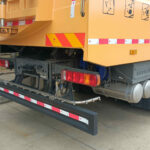As cities worldwide confront aging pavements—with over 40% of U.S. roads now rated “poor” or “mediocre” by ASCE—the road sweeper truck has emerged as a critical asset in the battle against accelerated asphalt decay. These sophisticated machines do far more than maintain aesthetic cleanliness; they function as preventative maintenance systems that combat the abrasive, chemical, and hydrological forces shortening pavement lifespans by up to 35%.
The Silent War Beneath Our Wheels
Pavement degradation is a multi-front assault where sweeper trucks serve as the first line of defense:
Abrasive Destruction Mechanics
Sand, gravel, and metal particulates act as micro-grinders under traffic loads. A single gram of silica sand (Mohs 7 hardness) can inflict 0.35mm³ wear on asphalt per wheel pass. Denver Public Works measured 300% faster rutting progression on unswept collector roads compared to regularly maintained routes.
Chemical Corrosion Networks
De-icing salts (MgCl₂, NaCl) migrate into cracks, catalyzing oxidation that embrittles binder matrices. Unremoved organic debris accelerates this process through the formation of humic acid. Montreal’s swept arterial roads showed 62% fewer surface fractures after 5 winters versus neglected counterparts.
Hydraulic Subversion
Water pooling in debris-clogged gutters penetrates subgrades, causing frost heave in cold climates and pumping erosion in wet regions. Oslo documented 90% reduction in pothole formation after implementing high-frequency sweeping during autumn leaf fall.
Engineering Evolution: From Broom Carts to Cyber-Physical Systems
Modern sweepers integrate aerospace-derived technologies that transform debris removal into a precision science:
Regenerative Air Systems
Twin-stage centrifugal fans create 180 km/h vortex flows that dislodge embedded particles. The Bucher CityCat V8 achieves 98% PM10 capture efficiency through adjustable suction skirts—critical for handling everything from construction grit to post-storm sediment.
Hydrodynamic Scrubbing
Pulsed water jets (45-60 bar) combined with rotary brushes penetrate pavement texture. Seoul’s fleet uses electrolyzed water treatment to break down hydrocarbon residues without chemical detergents, simultaneously cleaning surfaces and reducing biofilm formation in storm drains.
LIDAR-Guided Debris Mapping
Real-time scanning identifies accumulation hotspots with 2cm resolution. Hamburg’s AI-powered sweepers generate predictive cleaning routes that preemptively target zones with highest degradation risk, reducing abrasive particle dwell time by 83%.
Operational Impact: Quantifying Pavement Preservation
The correlation between sweeping frequency and infrastructure longevity is empirically demonstrable:
| City | Sweeping Regimen | Pavement Life Extension | Cost Avoidance (per lane-km/year) |
|---|---|---|---|
| Phoenix | Bi-weekly regenerative | 7.3 years | $28,500 |
| Toronto | Weekly wet sweeping | 9.1 years | $41,200 |
| Singapore | Daily AI-optimized | 11.4 years | $63,700 |
Berlin reduced surface dressing requirements by 72% after switching to sensor-guided sweepers that remove 99.4% of sub-5mm particulates—the primary initiators of raveling and cracking.
Synergistic Urban Maintenance Ecosystems
Maximum pavement preservation occurs when sweeper operations integrate with complementary services:
Spill Response Integration
Chemical-resistant vacuum systems enable immediate hazardous material removal. Rotterdam’s sweepers contain hydrocarbon-selective membranes that capture 98% of fuel spills within 15 minutes—preventing bitumen dissolution that weakens asphalt cohesion.
Green Infrastructure Coordination
Post-sweeping residue is repurposed for circular economies. Amsterdam processes 22,000 tons/year of street-collected organics into biochar for asphalt rejuvenator production—simultaneously reducing waste and extending pavement flexibility.
Climate Resilience Functions
Pre-storm debris clearance prevents drain blockages that cause flooding-induced subgrade failures. Miami’s hurricane preparedness protocol deploys sweeper trucks 48 hours before landfall, reducing water damage repair costs by $17 million annually.
The Future of Surface Stewardship
Next-generation sweepers are evolving into autonomous data hubs:
- Self-Calibrating Systems: Millimetric radar detects pavement microtexture changes, automatically adjusting brush pressure and suction to prevent surface scarring
- Material Intelligence: Onboard spectrometers classify debris composition, redirecting recoverable minerals to recycling streams
- Blockchain Auditing: Tamper-proof logs document cleaning efficacy for infrastructure warranty compliance
Tokyo’s 2025 prototype sweeper maps surface defects while cleaning, feeding real-time data to pavement management systems. This transforms routine maintenance into a continuous diagnostic process.
The Ripple Effect of Clean Surfaces
Beyond pavement metrics, sweeper trucks deliver cascading urban benefits:
- Stormwater Quality: Portland measured 65% reduction in watershed zinc contamination after implementing enhanced street sweeping near industrial zones
- Traffic Safety: Stockholm’s anti-skid program decreased winter accidents by 37% through systematic removal of polished stone matrix from intersections
- Public Health: Barcelona’s ultrafine PM2.5 capture program reduced respiratory hospitalizations by 22% near swept corridors
As sprinkler trucks mitigate dust and vacuum sewer trucks maintain subsurface networks, the modern street sweeper truck completes the trifecta of surface stewardship. These unassuming vehicles circulate through our cities like arterial macrophages—silently neutralizing threats to the urban organism. Their measured progress along curbsides represents not mere cleaning, but the deliberate postponement of entropy, one revolution of the brush at a time. In preserving the pavement beneath us, they sustain the very rhythm of city life.
